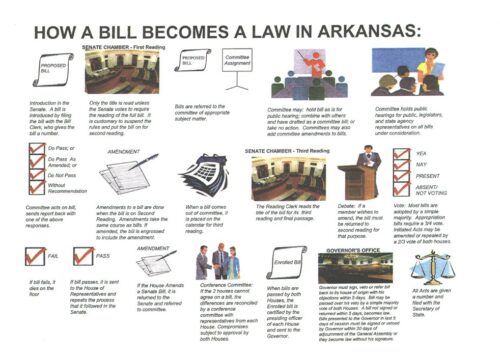4.10.24 – KHBS- Adam Roberts, DMM

The path from an idea to a law requires several steps.
This guide can help you follow the Arkansas General Assembly’s Fiscal Session.
The Assembly is made up of a House and Senate. Both houses are controlled by Republicans.
But there are several things that need to happen before any of their ideas turn into laws.
How A Bill Becomes A Law In Arkansas
The path from an idea to a law requires several steps. This guide can help you follow the Arkansas General Assembly as it considers changes to state law.
- Bill Is Written: A constituent or lobbyist approaches a lawmaker with an idea for a bill. The lawmaker meets with an attorney for the Bureau of Legislative Research to write the bill.
- Bill Is Filed: The lawmaker brings the bill to either the Arkansas State House or the Arkansas State Senate. It’s given a number, starting with HB1001 for House bills and SB1 for Senate bills.
- First & Second Readings: The bill is read before the House or Senate. The second reading usually follows the first.
- Bill Goes to Committee: The bill is sent to the appropriate committee. For example, a bill on teacher pay might go to the Senate Education Committee, while a bill on bus service might go to the House Public Transportation Committee. The committee will usually hold hearings on the bill.
The committee then makes a choice. It will decide to do one of four things with the bill:
- Recommends “Do Pass”: The bill moves on to the Third Reading.
- Recommends “Do Pass As Amended”: The amendments start over at the beginning of the process, just like the bill did.
- Recommends: “Do Not Pass”: The bill is effectively dead.
- Takes No Action: Nothing happens. The bill is effectively dead.
Third Reading: If the bill gets a “Do Pass” recommendation, it is brought before the full House or Senate for a third reading. The members debate the bill. If an amendment is proposed, it goes back to a second reading. Otherwise, the House or Senate votes.
Bill Passes: The bill is sent to the other chamber of the General Assembly for a first reading. It then follows the same process above.
Bill Fails: It usually only takes a simple majority to pass a bill. However, appropriation bills require a three-fourths majority and may be harder to pass.
When the other chamber has voted, one of three things will happen.
Bill Passes: The bill goes to the governor.
Amendment: If the second chamber votes to amend the bill, the first chamber must vote on that amendment.
Bill Fails: The bill is dead.
Once the governor gets a passed bill, she has five days to make a decision. She can do one of three things:
Sign The Bill: It becomes law.
Veto The Bill: The General Assembly can override the veto with a simple majority.
Do Nothing: The bill automatically becomes law.
Once a bill becomes a law, it is called an “Act.” Many bills take effect 90 days after the General Assembly adjourns. However, a bill might include language that says it takes effect immediately or at another date in the future.
